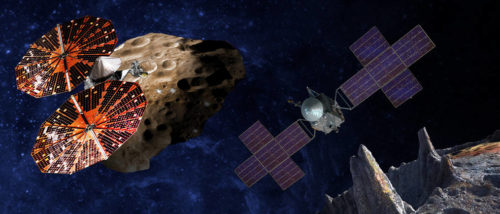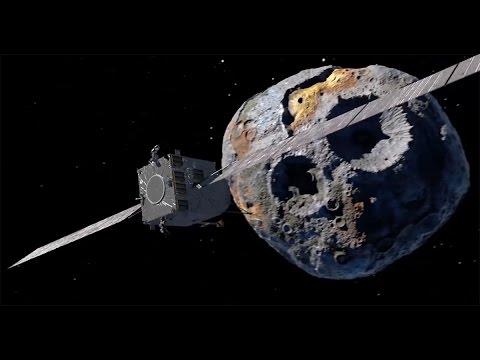
Credits: SwRI and SSL/Peter Rubin
NASA’s Hubble Space Telescope has discovered a rare, heavy and immensely valuable asteroid called “16 Psyche” in the Solar System’s main asteroid belt between Mars and Jupiter.
Given the asteroid’s size, its metal content could be worth $10,000 quadrillion ($10,000,000,000,000,000,000), or about 10,000 times the global economy as of 2019.
Asteroid Psyche is located at roughly 230 million miles (370 million kilometers) from Earth and measures 140 miles (226 kilometers) across, about the size of West Virginia. What makes it special is that, unlike most asteroids that are either rocky or icy, Psyche is made almost entirely of metals, just like the core of Earth, according to a study published in the Planetary Science Journal on Monday.
“We’ve seen meteorites that are mostly metal, but Psyche could be unique in that it might be an asteroid that is totally made of iron and nickel,” said Tracy Becker, one of the study’s authors and a planetary scientist at the Southwest Research Institute in San Antonio, Texas.
Psyche is the target of the NASA Discovery Mission Psyche, expected to launch in 2022 atop a SpaceX Falcon Heavy rocket. Further facts about the asteroid, including its exact metal content, will hopefully be uncovered when an orbiting probe arrives in early 2026.
NASA Selects Two Missions to Explore the Early Solar System
Lucy, a robotic spacecraft, is scheduled to launch in October 2021. It’s slated to arrive at its first destination, a main belt asteroid, in 2025. From 2027 to 2033, Lucy will explore six Jupiter Trojan asteroids. These asteroids are trapped by Jupiter’s gravity in two swarms that share the planet’s orbit, one leading and one trailing Jupiter in its 12-year circuit around the sun. The Trojans are thought to be relics of a much earlier era in the history of the solar system, and may have formed far beyond Jupiter’s current orbit.
“This is a unique opportunity,” said Harold F. Levison, principal investigator of the Lucy mission from the Southwest Research Institute in Boulder, Colorado. “Because the Trojans are remnants of the primordial material that formed the outer planets, they hold vital clues to deciphering the history of the solar system. Lucy, like the human fossil for which it is named, will revolutionize the understanding of our origins.”
Lucy will build on the success of NASA’s New Horizons mission to Pluto and the Kuiper Belt, using newer versions of the RALPH and LORRI science instruments that helped enable the mission’s achievements. Several members of the Lucy mission team also are veterans of the New Horizons mission. Lucy also will build on the success of the OSIRIS-REx mission to asteroid Bennu, with the OTES instrument and several members of the OSIRIS-REx team.
The Psyche mission will explore one of the most intriguing targets in the main asteroid belt – a giant metal asteroid, known as 16 Psyche, about three times farther away from the sun than is the Earth. This asteroid measures about 130 miles (210 kilometers) in diameter and, unlike most other asteroids that are rocky or icy bodies, is thought to be comprised mostly of metallic iron and nickel, similar to Earth’s core. Scientists wonder whether Psyche could be an exposed core of an early planet that could have been as large as Mars, but which lost its rocky outer layers due to a number of violent collisions billions of years ago.
The mission will help scientists understand how planets and other bodies separated into their layers – including cores, mantles and crusts – early in their histories.
“This is an opportunity to explore a new type of world – not one of rock or ice, but of metal,” said Psyche Principal Investigator Lindy Elkins-Tanton of Arizona State University in Tempe. “16 Psyche is the only known object of its kind in the solar system, and this is the only way humans will ever visit a core. We learn about inner space by visiting outer space.”
Psyche, also a robotic mission, is targeted to launch in October of 2023, arriving at the asteroid in 2030, following an Earth gravity assist spacecraft maneuver in 2024 and a Mars flyby in 2025.
In addition to selecting the Lucy and Psyche missions for formulation, the agency will extend funding for the Near Earth Object Camera (NEOCam)project for an additional year. The NEOCam space telescope is designed to survey regions of space closest to Earth’s orbit, where potentially hazardous asteroids may be found.
“These are true missions of discovery that integrate into NASA’s larger strategy of investigating how the solar system formed and evolved,” said NASA’s Planetary Science Director Jim Green. “We’ve explored terrestrial planets, gas giants, and a range of other bodies orbiting the sun. Lucy will observe primitive remnants from farther out in the solar system, while Psyche will directly observe the interior of a planetary body. These additional pieces of the puzzle will help us understand how the sun and its family of planets formed, changed over time, and became places where life could develop and be sustained – and what the future may hold.”
Discovery Program class missions like these are relatively low-cost, their development capped at about $450 million. They are managed for NASA’s Planetary Science Division by the Planetary Missions Program Office at Marshall Space Flight Center in Huntsville, Alabama. The missions are designed and led by a principal investigator, who assembles a team of scientists and engineers, to address key science questions about the solar system.
The Discovery Program portfolio includes 12 prior selections such as the MESSENGER mission to study Mercury, the Dawn mission to explore asteroids Vesta and Ceres, and the InSight Mars lander, scheduled to launch in May 2018.
NASA’s other missions to asteroids began with the NEAR orbiter of asteroid Eros, which arrived in 2000, and continues with Dawn, which orbited Vesta and now is in an extended mission phase at Ceres. The OSIRIS-REx mission, which launched on Sept. 8, 2016, is speeding toward a 2018 rendezvous with the asteroid Bennu, and will deliver a sample back to Earth in 2023. Each mission focuses on a different aspect of asteroid science to give scientists the broader picture of solar system formation and evolution.
Read more about NASA’s Discovery Program and missions at:
